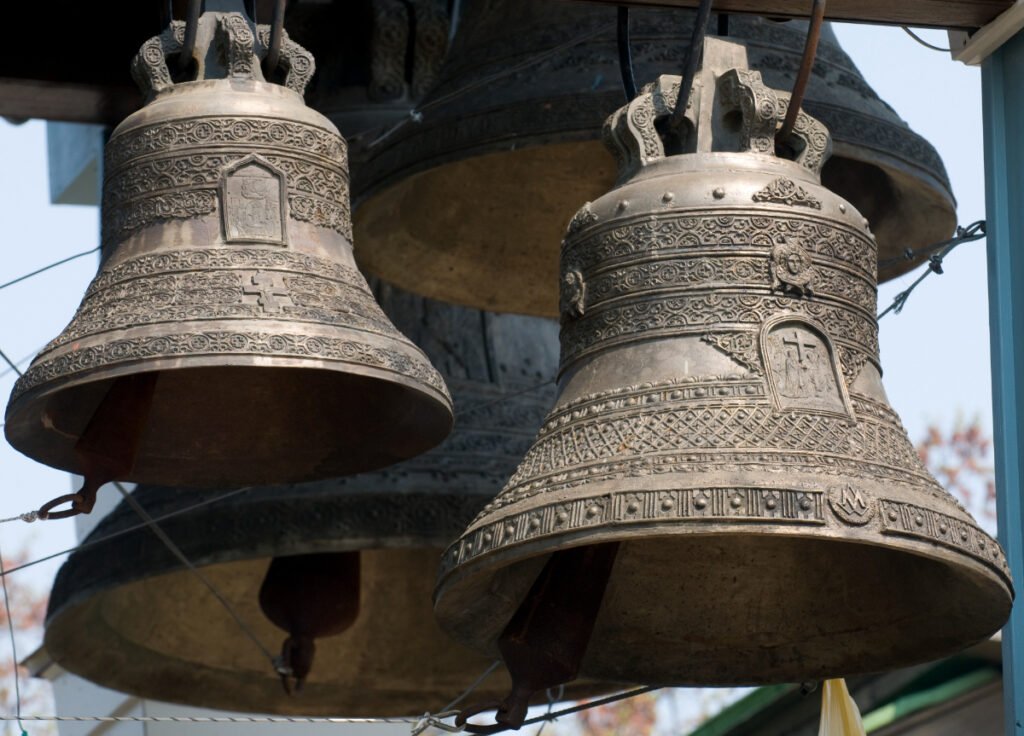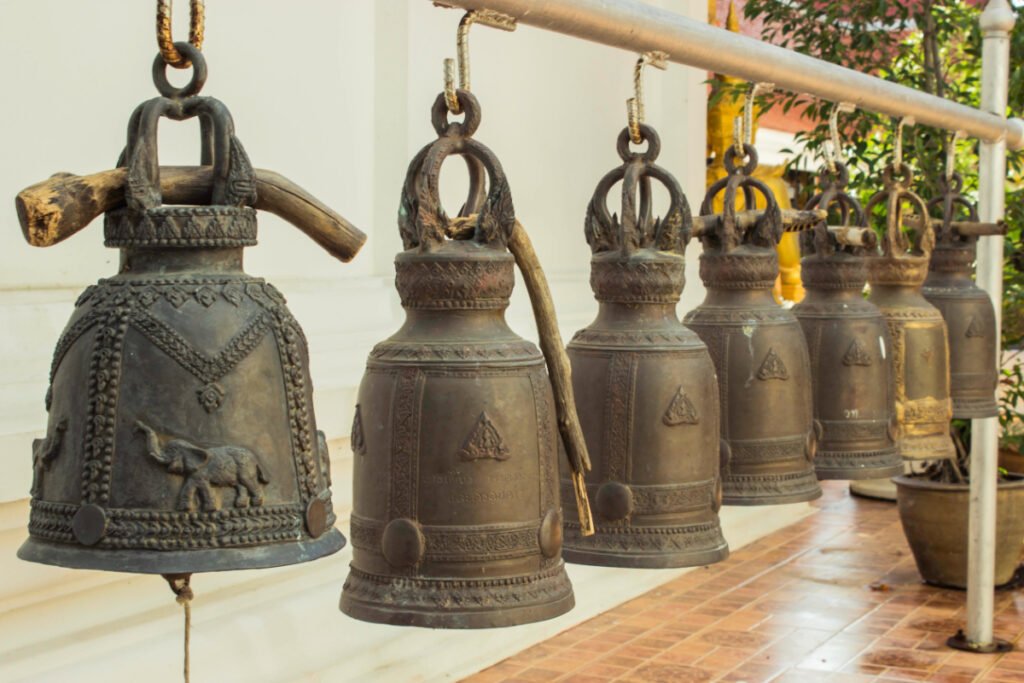Did you know those 500-year-old large and rusty bells in churches and farms cost up to $5,000 today? Well, thanks to their handmade carvings, marks, and details, an old cast iron bell has a huge and pricey demand in the antique market!
But for such a high value, your bell must have some regional themes, brands, and shapes that make it stand out from the rest! And, if you want to get the right price for all such minute details of your old cast iron bell, here’s a value guide you can follow!
Key Takeaways
- Antique cast iron bells with original size, weight, purpose, and religious marks fetch thousands of dollars in the antique market.
- Rare church, chapel, railroad, and ship bells value more because of their original inscriptions, prayers & rail logos.
- Want branded cast iron bells? Look no further than the signed and marked bells from Whitechapel Bell Foundry, Mcshane Bell Foundry, and William Blake & Co.
- Try to get carved cast iron bells with religious, patriotic, or railroad motifs, as they sell fast and for better value.
Key Features of Rare & Valuable Antique Cast Iron Bells

You can identify rare cast iron bells by their crude edges and bumped surfaces. But, for the VALUABLE ones, you must explore the following details:
- Religious or community-specific inscriptions on the yoke or stand
- Extra clappers or spoked wheels for deep ringing
- Warm golden yellow or greenish patina on the surface
- Mellow or resonant sounds with a deep & distinct pitch
- Might have bronze, brass, or copper accents & holders
- Raised bead lines along the edges and top
- Curved & single-piece shoulders with a chain or rope
History & Evolution of Antique Cast Iron Bells
Old and collectible Western bells date back to 4th-century Europe. But even before that, we had some thick cast-iron bells in 2000 BC Asia. These didn’t have sturdier chains and crowns. And since they were thick and heavy, people installed them outside on a stand.
Then, during the Renaissance, the Nordic makers introduced thin, cast bells. These had smaller clappers and heads and a high-pitch but low-volume sound. Also, such carved bells were more for churches, cathedrals, and religious uses.
So for the next few years, makers worked on adding seamed lips, mouths, and bead lines to their bells. In fact, some also used tin and copper alloys for more sound. Soon, people started using such bells for schools, barns, and sheds too!
However, in 1832, Alexander Graham Bell introduced the first electronic bell, which was light and automatic. And that’s when people stopped using vintage cast iron bells, making them collectible today!
8 Types of Antique Cast Iron Bells (With Values)

Since antique cast iron bells were invented, makers tweaked them for different farm and religious uses, giving us different types of cast iron bells. Find the values of these eight most popular bell types in the price chart below:
| Antique Cast Iron Bell Type | Years | How to Identify Them? | Estimated Value |
| Farm or Dinner Bells | 1800s – 1900s | 10 – 20 inch bells with unique natural carvings & a clear, loud ring | $100 – 1200 |
| Church & Chapel Bells | 4 – 5th Century | Large 20 – 60 inch bells with intricate religious designs, inscriptions, and deep, resonant sound | $1,000 – 20,000 |
| School Bells | 1800s | 20 – 30 inch bells with solid wooden frames, handles, and hand-ringing surfaces | $70 – 1,200 |
| Firehouse Bells | 1800s – 1930s | Elongated, 12 – 15 inch bells with brass or copper accents and fire department logos | $50 – 900 |
| Railroad Bells | 1800s | Round and elongated bells with black, red, and green accents and railroad stamps | $150 – 2,000 |
| Livestock or Sleigh Bells | 1700s | Small 2-5 inch bells, each with the farm or animal name, brass or bronze chains, and a clear, ringing sound | $200 – 6,000 |
| Door or Counter Bells | 1800s | Medium-sized, 4 – 10 inch bells having arched, carved brackets & black, green, yellow, or red finishes | $80 – 1,200 |
| Ship Bells | 1700s | 6 – 24 inch bells, each having spoked wheels, ship logos & wood or metal mounting stands | $100 – 3,000 |
6 Factors That Impact a Vintage Cast Iron Bell’s Value
Yes, old cast iron bells cost $40 – 1000 depending on age, condition, and theme. In fact, some branded ones fetch up to $3000 for their original marks and signs. Let’s see how different marks, brands, and themes affect your antique cast iron bell’s value below:
1. Manufacturing Year & Age

Old cast iron bells don’t have any dates or labels. Yes, you might see a ‘Pat. 1886’ stamp on some of them, but it’s for the newer 1800s models. So observe these visual features to know if your iron bell is old and valuable:
- Check for single-piece designs without any casting or mold marks on the head
- Look for soft, irregular, and curved edges with uneven thickness
- Engraved manufacturer or retailer stamps on the crowns
And if you want to know the exact era and value, refer to the table below:
| Old Cast Iron Bell Years | Age | Top. Collectible Features | Average Cost |
| Medieval Period (500 AD – 1500 AD) | 523 – 1523 years | Small & uneven bells with religious or feudal carvings, crude, rugged edges, hammered finishes, and basic casting techniques | $4,000 – 20,000 (as per the condition) |
| Renaissance (1500s – 1700s) | 323 – 523 years | Large and patterned bells – natural or floral, each having superior iron chains, inscriptions, and casting techniques | $1,000 – 6,000 |
| Industrial Revolution (1700s – 1800s) | 223 – 323 years | Cast or molded bells with distinctive book farm or institution carvings, sleek, streamlined edges, and steel accents | $300 – 2,000 |
| 1900s | 100 – 200 years | Small. 2-10 inch bells with painted or galvanized surfaces, molded finishes, and elongated shape. Plus, most have visible markings – serial numbers or marks | $30 – 1,500 |
Pick antique cast iron bells with a raw iron, oxidized, or gilded gold leaf finish for an old make.
2. Marks and Logos

It’s true that the earliest 1500 AD bells didn’t have any marks or carvings. But then, by the 1800s, makers added some marks and inscriptions to track their age and value. So let’s check how to spot, analyze, and value each of them below:
- Size & Weight Marks: If your antique cast iron bell has stamped 100 – 2,000 lbs marks, it might be a new 1800s bell worth $70 – 2500. Also, check if it has a diameter of at least 20 – 30 inches for a higher value.
- Purpose Marks: Does your old cast iron bell have stamped ‘Fire,’ ‘School,’ or ‘Farm’ labels? If yes, it might be an 1850s regional bell, costing $30 – 900. Such bells have unique local marks & regional significance that make them collectible!
- Religious Inscriptions: Antique cast iron bells with religious or natural slogans were very popular after the Renaissance. Such intricate and marked bells usually cost up to $4,000.
But if you want the exact values, refer to the table below:
| Vintage Cast Iron Bell Inscriptions | Years | Average Value |
| ‘Praise God from whom all blessings follow.’ | 1600s – 1700s | $500 – 4,000 |
| ‘O Lord, save thy people.’ | 1800s | $100 – 2,000 |
| ‘In God we trust.’ | 1900s | $30 – 1,200 |
| ‘Jesus Saves.’ | 1900s | $30 – 1,200 |
3. Bell Themes

Not all cast iron bells were used in temples and churches. Some vintage 1800s bells had natural farm, book, or railroad themes for schools and railways too! So let’s check how such unique themes affect a cast iron bell value below:
| Antique Cast Iron Bell Themes | Estimated Value |
| Religious – temple, church, floral, and scripture designs | $1,000 – 15,000 |
| Patriotic themes – flags, logos & military pin symbols | $200 – 2,500 |
| Railroad themes – Railways, ships, and transport designs | $100 – 2,000 |
| Farm – Animal & Dinosaur designs | $100 – 1,200 |
| School designs – books, school desks, and emblems | $70 – 1,200 |
| Decorative or artistic – Ornate patterns, landscapes & abstract designs | $30 – 900 |
Try to get antique cast iron bells with floral, linear, or abstract patterns for a higher value.
4. Brands & Manufacturers

There’s no doubt that branded cast iron bells fetch the highest value, even up to $5,000. So, to check if your bell is branded, rotate it and see if there’s any engraved logo or sign on its yoke or head.
And if you get one, you can value it as follows:
| Vintage Cast Iron Bell Brands | Years | Average Price |
| C.S Bell Co. | 1875 & Above | $200 – 4,000 |
| McShane Bell Foundry (Church Bells) | 1856 | $500 – 6,000 |
| Buckeye Bell Foundry | 1850s | $800 – 3,000 |
| White Chapel Bell Foundry | 1570 – 2000 | $70 – 20,000 as per age |
| Meneely Bell Foundry | 1800s – 1900s | $700 – 8,000 |
| William Blake & Co. | 1800s – 1900s | $500 – 6,000 |
5. Bell Shape

An old cast iron bell’s shape tells a lot about its value! For instance, geometrical, conical, or flat top bells fetch the highest returns due to their molded bodies. In contrast, the newer saucer or square bells are relatively cheaper due to their thin, hollow profiles.
Let’s check how different cast iron bell shapes affect their costs:
| Antique Cast Iron Bell Shapes | Estimated Cost |
| Spherical, Hemispherical, or Round | $300 – 15,000 |
| Conical & Elongated | $200 – 6,000 |
| Cylindrical & Tube-like | $100 – 4,000 |
| Flat & Linear bells | $200 – 5,000 |
| Waisted & Pinched bells | $100 – 2,000 |
| Saucer-like, Square or Rectangular | $30 – 1,200 |
6. Colors & Finishes
Old cast iron bells with original gray or black surfaces cost $1,000 – 2,000 more than others. Collectors also pay more for bells with gilded gold or metallic silver colors, as these have a better shine and durability than paint.
So just observe your cast iron bell, note its color, and compare the values below:
| Antique Cast Iron Bell Values | Average Value |
| Dark Gray & Black (Original Cast Iron Finish) | $300 – 10,000 |
| Brownish-Red & Orange | $100 (if rusty) – 5,000 |
| Green & Blue | $70 – 3,000 |
| Yellow & Golden (Gold Gilded) | $500 – 6,000 |
| Silver (Nickel-plated) | $100 – 3,000 |
How Do You Clean Antique Cast Iron Bells?
Rinse the bell thoroughly with water and air-dry it for 2-3 hours. Next, take a wire brush and scrub off any loose paint or rust flakes that might have built up on the surface. Alternatively, you can sandblast the bell and seal it with primer for more shine.
Which Oil Should You Use to Clean Old Cast Iron Bells?
To clean and polish your antique cast iron bells, you can use any regular avocado, canola, grapeseed, peanut, or soybean oil.
If you want an old cast iron bell for your home but the values confuse you, this guide is a lifesaver! Apart from identifying REAL cast iron, you can value it using its brands, shapes, & more! So just observe your bell and start comparing it from the above tables.
And if you want to identify and value other cast-iron antiques like cast iron skillets and sad irons, I’ll be happy to help!
Note: This article is intended for informational, educational, and entertainment purposes only. Some images are illustrative and may not represent actual brands, products, or related entities. All trademarks, product names, brand logos, packaging, and other intellectual property referenced remain the exclusive property of their respective owners. Any brand mentions or references are provided solely for descriptive and educational context and do not imply any formal or commercial association.










